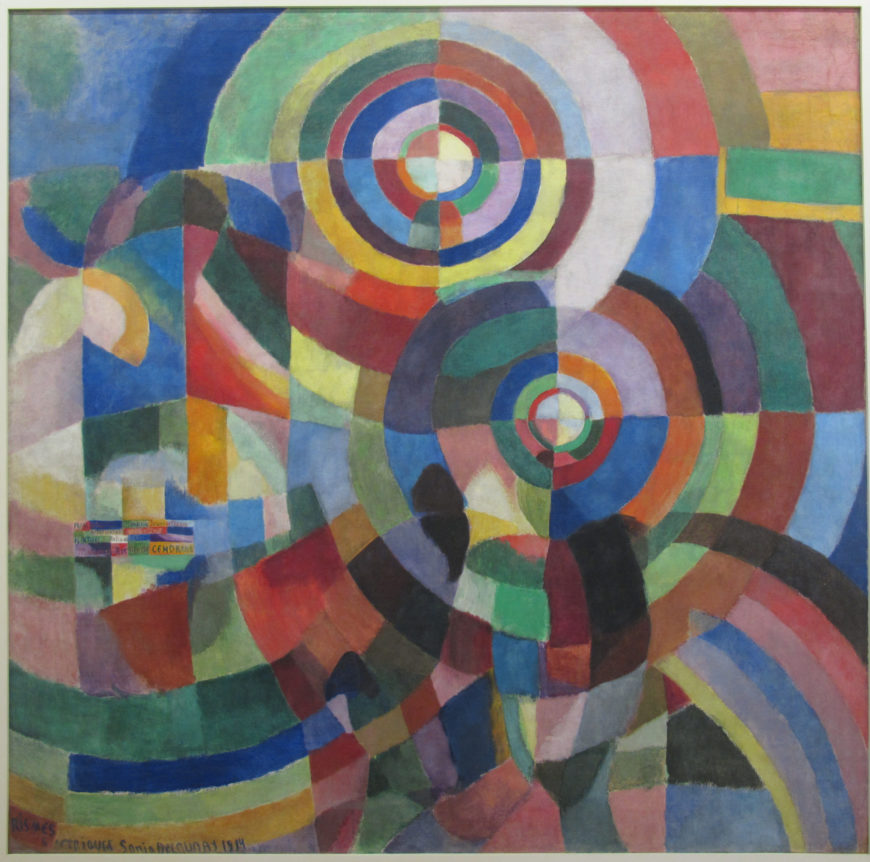Sonia Delaunay
by DR. CHARLES CRAMER and DR. KIM GRANT[1]

Almost eleven feet wide, Sonia Delaunay’s Bal Bullier creates an overwhelming impression of brilliant color and movement. The composition juxtaposes rectangular geometric forms and circles with more fluid curved shapes, loosely structured across the canvas in a rhythmic pattern of dark and light verticals.
A modern dance hall
The Bal Bullier was a dance hall in Paris that Delaunay frequently visited with her husband, Robert. Her painting shows a scene of modern urban life comparable to those painted by the Impressionists in the late 19th century, such as Auguste Renoir’s Moulin de la Galette.
If you look closely at the dark shapes in the center you will see the abstracted forms of couples dancing the tango. The dance, which originated in sailors’ bars in Argentina, was very popular in Paris in the early 20th century. It is renowned for its erotic intensity and requires a very tight embrace between partners, which Delaunay represents in the interlocking curves of the figures.
The Delaunays were committed to developing Simultanism as a post-Cubist style of modern painting focused on color relationships, and to the depiction of modern subjects. In addition to the dance hall, Sonia painted the new electric street lights in Paris, and Robert painted the Eiffel Tower, rugby matches, and airplanes.

Sonia’s Electrical Prisms is both a display of color relationships and an abstracted depiction of her first experience of electric streetlights on a Paris boulevard. The streetlights become discs of radiating color that permeate the entire canvas, but there are also suggestions of solid forms. A tall kiosk with books or magazines is on the left, and parts of some shadowy figures appear in the lower half of the painting, almost completely absorbed into the brilliant colors of the electric light.
Intuition vs. intellect
Interestingly, in Western art theory color is thought to appeal directly to the senses, in contrast to drawing’s supposed appeal to the intellect; thus, Sonia’s purportedly intuitive approach to color was aligned with traditional Western conceptions of color’s role in art. It should be noted, however, that Sonia formally studied art for several years in a German academy and an art school in Paris, while Robert’s formal artistic training was limited to a two-year apprenticeship with a theatrical designer in Paris.
Abstraction and representation
Unlike many of their contemporaries who developed abstract painting styles that progressed from representation to pure abstraction, the Delaunays painted representational and non-representational Simultanist works at the same time. Modern objects such as the Eiffel Tower and airplanes as well as scenes of dance halls and rugby games were enveloped in the prismatic color planes of Simultanism. Like the Italian Futurists, the Delaunays created a post-Cubist style appropriate to the modern city, and Sonia expanded her art beyond the limits of the easel painting to engage with everyday life.
Additional resources:
- Dr. Charles Cramer and Dr. Kim Grant, "Sonia Delaunay," in Smarthistory, April 7, 2020, accessed March 15, 2023, https://smarthistory.org/simultanism-sonia-delaunay/. ↵

